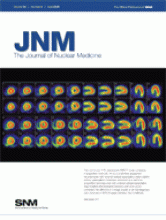Connecting the quantum dots: Bentolila and colleagues provide an overview of the growing contributions of quantum dots to in vivo molecular imaging in small-animal models and describe the possibilities for clinical applications and novel hybrid approaches.
Page 493

Toward routine vulnerable plaque imaging: Fox and Strauss offer a perspective on the current status of metabolic imaging of vulnerable plaque in coronary arteries and preview an article on this topic in this issue of JNM.
Page 497

Testing a PET/CT cocktail: Iagaru and colleagues report on the combined administration of 18F and 18F-FDG in a single PET/CT study for cancer detection in a range of malignancies.
Page 501

PET/CT evaluation of ascites: Zhang and colleagues compare 18F-FDG PET/CT with CT alone in determining the unknown primary cause of ascites and in detecting abdominal cavity metastases.
Page 506

18F-FDOPA PET for pheochromocytomas: Imani and colleagues investigate the sensitivity and specificity of PET with18F-FDOPA as an independent marker for diagnosis and localization of benign and malignant pheochromocytomas.
Page 513

Segmented attenuation maps for PET/MRI: Martinez-Möller and colleagues propose and evaluate a potential solution to the challenge of attenuation correction of whole-body PET data in combined PET/MRI.
Page 520

PET in diffuse large B-cell lymphoma: Itti and colleagues determine whether semiquantification of standardized uptake values improves the prognostic value of 18F-FDG PET after 4 cycles of chemotherapy for diffuse large B-cell lymphoma.
Page 527

Annexin imaging of joint prostheses: Lorberboym and colleagues explore the use of 99mTc-recombinant human annexin V imaging for differential diagnosis of aseptic loosening and low-grade infection in hip and knee prostheses.
Page 534

PET/CT in chronic lung disease: Groves and colleagues evaluate integrated 18F-FDG PET/CT in idiopathic pulmonary fibrosis and other forms of diffuse parenchymal lung disease and assess patterns of tracer metabolism in these patients.
Page 538

SPECT in stable ischemic heart disease: Gimelli and colleagues compare the capabilities of gated stress/rest myocardial perfusion SPECT with those of a complete diagnostic work-up and other indicators in predicting cardiac events in patients with stable ischemic heart disease.
Page 546
Half-time SPECT MPI with AC: Ali and colleagues describe a new algorithm and postprocessing technique facilitating half-time gated myocardial SPECT perfusion imaging with attenuation correction.
Page 554
PET/CT imaging of coronary plaque: Wykrzykowska and colleagues report on 18F-FDG PET/CT imaging of inflamed and vulnerable plaque in coronary arteries using a low-carbohydrate, high-fat preparation in patients with suppression of myocardial uptake.
Page 563

Radiotracer breast cancer imaging: Lee and colleagues provide the first in a 2-part educational overview of current and future radiotracer imaging methods for breast cancer in the context of management strategies and nonnuclear imaging approaches.
Page 569

Antisense-mediated Auger cytotoxicity: Liu and colleagues evaluate a novel 3-component streptavidin-delivery nanoparticle capable of tumor targeting, transmembrane transport, 111In nuclear migration, and specific radiation-induced cytotoxicity.
Page 582

Side-chain coordination in HYNIC peptides: King and colleagues determine the effects of assisted coordination by amino acids, such as histidine and glutamic acid, on the function of 99mTc-labeled gastrin peptide–HYNIC conjugates in targeting cholecystokinin-R in small-animal models.
Page 591
U-SPECT-II rodent imaging system: van der Have and colleagues describe a new SPECT device that enables both molecular imaging of murine organs down to resolutions of less than 0.5 mm and high-resolution total-body imaging.
Page 599

PET imaging with anti-PSMA antibody: Elsässer-Beile and colleagues elucidate the in vivo behavior and tumor uptake of a radiolabeled anti–prostate-specific membrane antigen monoclonal antibody and review its potential as a PET tracer.
Page 606
MMP imaging in atherosclerotic mice: Ohshima and colleagues detail a strategy for noninvasive assessment of the extent of matrix metalloproteinase expression in various transgenic mouse models of atherosclerosis.
Page 612

Fibronectin stimulates 18F-FDG uptake: Paik and colleagues investigate the mechanisms by which matrix fibronectin influences endothelial cell glucose uptake and describe the signaling pathways that mediate this effect.
Page 618
LLP2A tumor targeting: DeNardo and colleagues review the design, synthesis, radiolabeling, and in vivo pharmacokinetics of derivatives of a high-affinity, high-specificity peptidomimetic ligand that binds the activated α4β1 integrin found on a variety of malignant lymphoid cell lines.
Page 625

Solid-state single-photon imaging: Gambhir and colleagues report on the development and validation, including patient scanning, of a new solid-state single-photon γ-camera and compare it with a conventional SPECT Anger camera.
Page 635

Ibritumomab tiuxetan dose estimate: Fisher and colleagues evaluate organ radiation absorbed doses from intravenously administered 111In- and 90Y-ibritumomab tiuxetan, as published in MIRD Dose Estimate Report No. 20.
Page 644

ON THE COVER
This rest/stress 99mTc-tetrofosmin SPECT study compares 2 acquisition methods. At top is a full-time acquisition reconstructed with ordered-subset expectation maximization without attenuation correction; at bottom is a half-time acquisition reconstructed with ordered-subset expectation maximization and resolution recovery with attenuation correction. No difference in image quality or clinical diagnosis was observed in 96% of cases between the 2 methods.
See Page 557.








